Redesigning Mecca
The ancient holy city had reached capacity. Gensler’s solution? Redesign the infrastructure, without changing the ceremony.
-
- 5
Each year, 2.5 million Muslims visit Mecca during the month of Dzulhijjah to complete the Hajj. It’s one of the five pillars of Islam—all adult Muslims who are physically and financially able must take a pilgrimage to the holy city for five days of ceremonies. But around 2010, Mecca had reached capacity, and projections showed that by 2020, 5 million Muslims could arrive for the Hajj. Best case scenario, pilgrims would be unable to complete their religious duties. Worst case scenario, people could be trampled in stampedes.
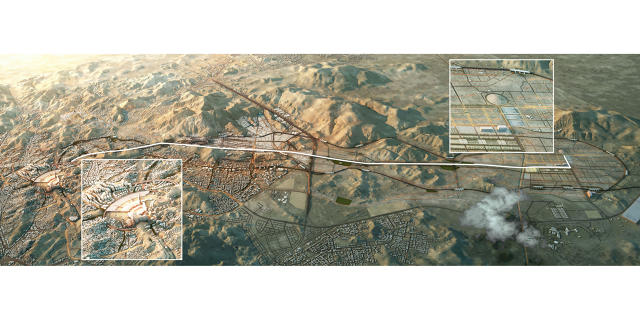
So the Saudi University, Umm Al-Qura, and the Ministry for the Hajj hired global architecture firm Gensler to remove bottlenecks and increase Mecca’s capacity.
“When you get down to it, the Hajj is the single largest human migration on the planet, period,” says Gensler partner Bill Hooper. “There are more that happen over extended periods of time in India, but when you talk about 5 million individuals moving from one point to another in a very, very time prescribed manner, to be able to complete the rituals as prescribed by the religion, nothing comes close.” And yet many of the architects at Gensler would need to design a solution without ever setting foot on the Muslim-only holy grounds.
Building A Real Pedestrian Highway
The first bottleneck that needed to be fixed was around the Plain of Arafat. On day two of the Hajj, millions of pilgrims gather here starting at sunrise, spend the day in prayer, and then head together within a single window just 30-minutes long to follow a 20-kilometer (about 12.4-mile) path, flooding highways and snaking toward Mecca’s mosque while performing ceremonies along the way.

Much like a traffic jam, too many people trying to go the same way at once can created various choke points, and people could get trapped in one pipeline toward Mecca with no real way out.
Gensler enlisted the management company Booz Allen to model millions of people walking the route.
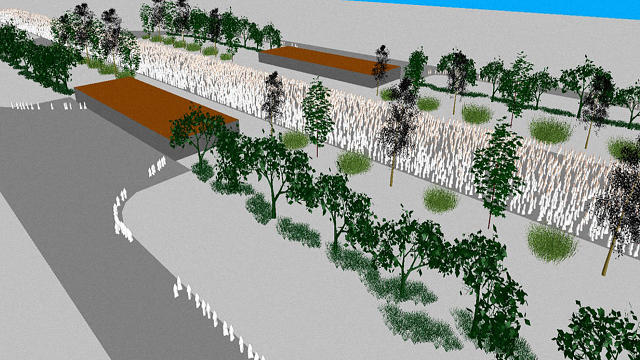
“What we found was, human beings, if you can allow them to self-distribute, will do this,” Hooper explains. “While [previous developers] were so busy working to widen the space, if you created lateral crossover movements—almost like crossover bridges—the pilgrims would solve their own density problem.”
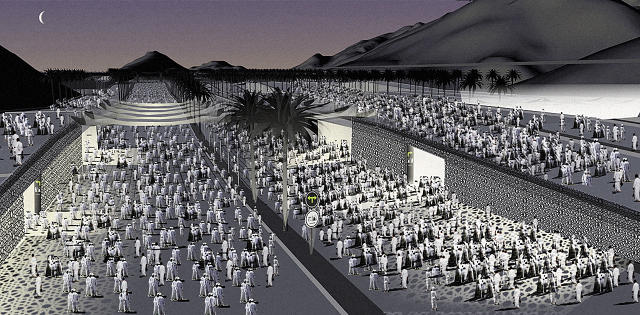
Gensler took the highway metaphor to its ultimate conclusion, adding exit ramps and overpasses for people on foot. They also created spaces for various amenities.
“No surprise, people need things: restrooms, water, maybe a little bit of food,” Hooper explains. “The human services that are required to support the Hajj route include huge numbers of tractor trailers to provide medical assistance, blankets, whatever’s necessary. So you get a lot of that stuff up off the ground, so we solved a number of problems and operational problems that we felt good about.”
A Stacked Center
On the final day of the Hajj, pilgrims walk around a cube-shaped temple, the Kaaba, seven times counterclockwise, creating a giant, whirlpool of humanity that by 2020 could contain the headcount equivalent of 50 Super Bowls inside. The rite is called the Tawaf, and it represents the second major issue Gensler had to solve.
When Gensler was brought in, pilgrims performed the Tawaf from two concentric positions: either from very close in the surrounding courtyard, or from much farther on the rooftop of a hexagonal structure circling the space.
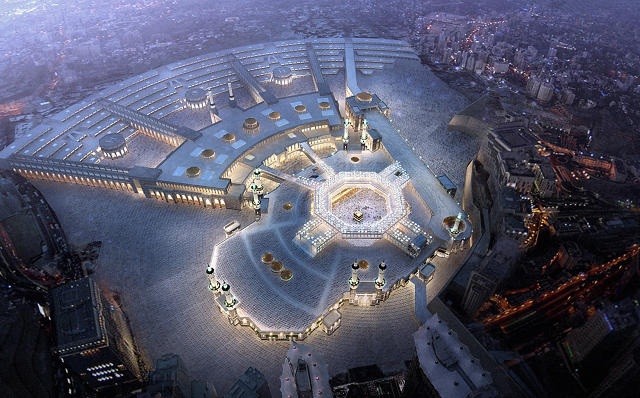
“No real surprise, if you’re close to the Kaaba, you might be able to complete Tawaf in 20 minutes, but if you’re much further out, maybe just 50 to 100 feet further out, it could end up taking you an hour or two hours,” Hooper explains.
As a result, the 50,000 people completing the Tawaf every hour had vastly different experiences. By geometry alone, some would be done quickly, while others would need much longer. Meanwhile, those who finished near the center would need to cut through the crowd to escape.
“You’d be moving across this enormous mass of humanity, and creating turbulence,” Hooper explains. Just a single person working against the human flow can cause a great rift, slowing the crowd, and distracting pedestrians from completing a sacred ceremony.
Gensler’s response was the only practical solution within the confines of Islam. To increase capacity, they had to add more vertical layers to the courtyard. The result almost looks like they planted the Guggenheim in the middle of Mecca. But instead of making the entire path one large spiral, Gensler gave the new structure discrete floors, layering the open-air rings like a series of halos.
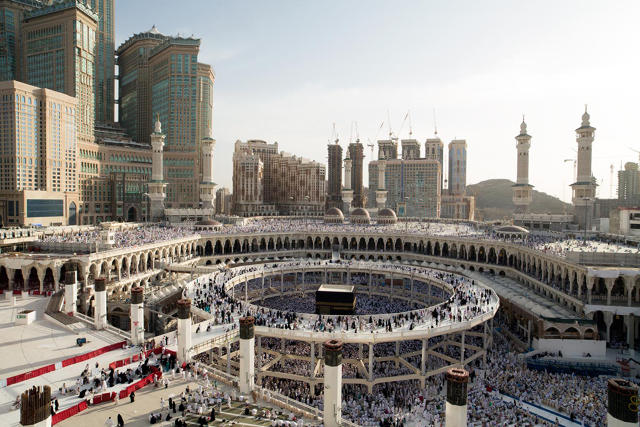 via SL Rasch
via SL Rasch A series of sky bridges brings Pilgrims into a level, and once they’re on that level, they stay on it until they complete the Tawaf (forcing people down a single path reduces problems that might arise from people who try to level-hop). While the rings eliminate Mecca’s open air feel, they also provide what Hooper calls a “sympathetic architecture,” offering shade during hot days and overhead lights at night. Again, Gensler brought in Booz Allen to map out the approach, and test if architectural elements like stairwells or corners would disrupt the flow.
As of today, Mecca has constructed two layers from Gensler’s design, and according to reports, it has made an immediate difference. A Saudi newspaper recently reported that the new footpaths have already doubled capacity so now 100,000 people can complete the Tawaf each hour. The capacity could scale, as the structure was designed to accommodate several additional floors if necessary.
Site Unseen
The most impressive part of the work wasn’t the design itself, but the fact that much of Gensler’s team was more or less working blind. Hooper—not being Muslim—may have led the Mecca project, but he wasn’t permitted to set foot inside the city. In fact, much of Gensler’s team worked on the design without being able to see the sites firsthand. (Just to outline the completed work for me, Hooper had to point to Getty Images and Google Earth. What’s more, Mecca uses a local construction company, so he saw some of Gensler’s designs implemented for the first time right alongside me.)

It was a decidedly unorthodox approach, and no doubt, had its drawbacks. Building something without ever seeing its real context, filled with real people, will lead to an inherently limited understanding of any project. But Hooper saw value in this “scientific detachment” shared by the non-Muslim members of his team.
“I think that what our value was, was to be able to bring a somewhat fresh perspective to a very, very intractable problem,” Hooper says. “I think it was equally valuable to have both Muslims and non-Muslims work on the project, because each one could enrich the conversation. Sometimes you need to have a dispassionate opinion on solving an architectural issue, other times you needed the richness of the opinion of someone who’d been in Mecca.”
An earlier version of this article incorrectly stated that the Hajj was performed during Ramadan.
[All Images (unless otherwise noted): courtesy of Gensler]
-
- 5
Each year, 2.5 million Muslims visit Mecca during the month of Dzulhijjah to complete the Hajj. It’s one of the five pillars of Islam—all adult Muslims who are physically and financially able must take a pilgrimage to the holy city for five days of ceremonies. But around 2010, Mecca had reached capacity, and projections showed that by 2020, 5 million Muslims could arrive for the Hajj. Best case scenario, pilgrims would be unable to complete their religious duties. Worst case scenario, people could be trampled in stampedes.

Fast Company , Read Full Story
(279)














